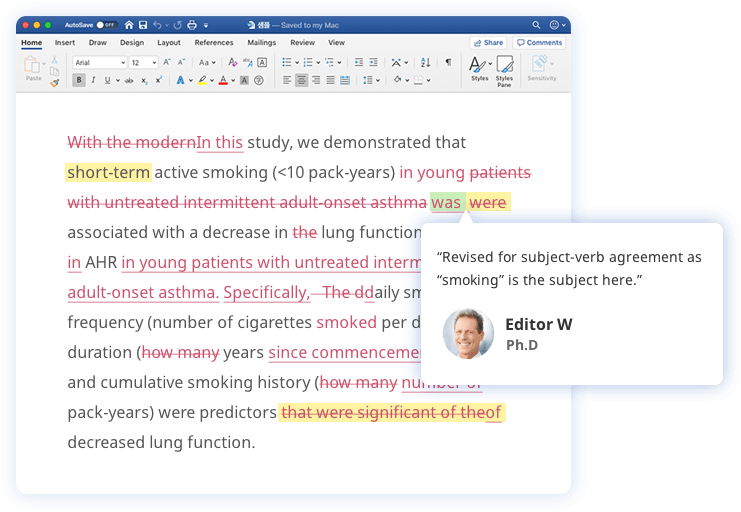センテンスの構造(語順に関するルール)
センテンスとは、1つの完全なアイデアを表現する複数のワードの一群で、主部と述部を含んでいます。最も基礎的なセンテンス構造は単一の節から成り立っています。しかし、多くのセンテンスは1つの主節と、1つ以上の従属する節を持ち合わせています。
英語のセンテンスの一般的な語順は、主語+動詞+目的語です。一見シンプルに見えますが、文の構造や複雑さによっては、主語(複数の場合もあり)、動詞(複数の場合もあり)、目的語(複数の場合もあり)の見分けが困難なケースもあります。センテンス構造には以下の4種類があります。
(1)単文(シンプル)
(2)重文(コンパウンド)
(3)複文(コンプレックス)
(4)重複文(コンパウンド-コンプレックス)
センテンス構造の種類
| センテンス構造の種類 | センテンスの構成パーツ | 例 |
|---|---|---|
| 単文 |
独立節 |
I like animals. |
| 重文 |
独立節+等位接続詞(またはセミコロン)+独立節 |
I like animals, but Molly prefers plants. |
| 複文 |
独立節+従位接続詞(または関係代名詞)+従属節 |
I like animals because they are cute. |
| 重複文 |
独立節+従位接続詞+従属節+等位接続詞+独立節 |
I like animals because they are cute, so I work at an animal shelter. |
単文の構造
単文は最も基礎的なセンテンス構造で、単一の独立節で構成されています。
節の種類
独立節は、完全なアイデアを表現し、完結したセンテンスとして機能できます。
- Example
- The proposed system has the advantage of a wide scope.
I went shopping last weekend.
The cat is sleeping by the window.
対照的に、従属節は完全なアイデアを表現しておらず、完結したセンテンスとして機能できません。
- Example
- which was developed over three months
even though I was tired
because the weather is sunny
よく使われる従位接続詞
because, since, once, although, if, until, unless, why, while, whether, than, that, in order to
よく使われる関係代名詞
that, which, who, whom, whoever, whomever
センテンスの主部
主部(主語)とは、センテンスのアクションを起こしているモノや人物のことです。主部は、センテンスの2つの基本構成要素のうちの最初の要素です。
- Example
- This study investigated the relationship between the personal traits and clinical parameters.
- Example
- Dolly made a cake for the party.
センテンスの述部
述部は動詞(アクション)を含んでおり、さらに詳しい背景を明らかにする情報を含めることもできます。
- Example
- This study investigated the relationship between the personal traits and clinical parameters.
- Example
- Mary gave her sheep a bath.
直接目的語と間接目的語
直接目的語は、アクションを受ける人、物、アイデアなどを指します。
- Example
- This study investigated the relationship between the personal traits and clinical parameters.
- Example
- Dolly made a cake.
間接目的語は、アクションがなされる対象の人、物、アイデアなどを指します。
- Example
- The national lab offered us an opportunity to work on an exciting new project.
- Example
- Mary gave her sheep a bath.
他動詞と自動詞の違い
他動詞は、主語が直接目的語について行うアクションのことです。
- Example
- We fabricated a composite.
上の例では、「we」が主語、「fabricated」が他動詞、「a composite」が直接目的語になります。
自動詞は、その後に目的語がなくてもよい動詞です。自動詞はそれ自体で述部として機能できます。
- Example
- We arrived.
We arrived early.
- Example
- I always eat.
I always eat before work.
上記2つの例ではそれぞれ「We」「I」が主語、「arrived」「eat」が自動詞です。
主語補語
主語補語は、主語を別の言い方で表したり(リネームする)、説明したりすることで補完します。主語補語は常に連結動詞の後にきます。連結動詞は「be」動詞の一形態になっていることが多いです。
- Example
- The material is a gold composite.
「Gold composite」は、主語である「the material」をリネームしています。
- Example
- Charlotte is very pretty.
「Pretty」は、主語である「Charlotte」について説明しています。
今すぐネイティブ専門校正者の英文校正を通してフィードバックを受け取ってください。

- 学術論文
- 留学志望動機書
- 英文履歴書
- 事業計画書
- ブログ、ウェブサイト
- 大学課題、自由英作文
重文の構造
重文は等位接続詞またはセミコロンでつながれた2つ以上の独立節で構成されています。アメリカ英語の規則では、複数の独立節をつなぐ際、等位接続詞はカンマと一緒に使う決まりになっています。
重文の構造: 独立節 + 等位接続詞 (またはセミコロン) + 独立節
等位接続詞のリスト: and, but, yet, or, nor, for, so
- Example
- The material is a gold composite, and it was fabricated in clean room no. 45.
- Example
- Glenda usually eats before work, but today she could not.
- Example
- The proposed system has the advantage of a wide scope; it uses a novel algorithm that expands the range by a factor of ten.
複文の構造
複文は、1つの独立節と1つの従属節で構成されています。
複文の構造: 独立節 + 従位接続詞 (または関係代名詞) + 従属節
- Example
- We built a new system because the previous model had to be narrowed in scope.
- Example
- Sarah will buy a train ticket if her flight is cancelled.
重複文の構造
重複文は2つ以上の独立節と1つ以上の従属節で構成されます。
重文複文構造: 独立節 + 従位接続詞 + 従属節 + 等位接続詞 + 独立節0
- Example
- The first method failed because it caused the wires to melt, but the second method succeeded in bending the wires without causing the same issue.
- Example
- Sarah’s flight took off before she started driving to the airport, so she drove to the train station instead.









